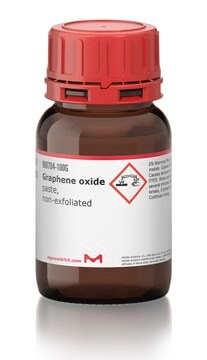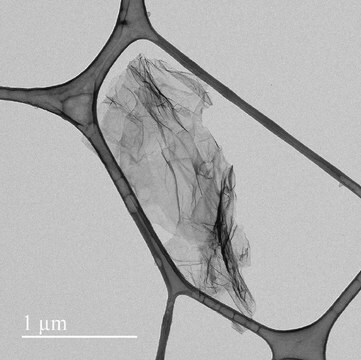777684
Reduced graphene oxide
Sinónimos:
rGO
About This Item
Productos recomendados
descripción
chemically reduced
Nivel de calidad
formulario
powder
composición
Carbon, ≥75 wt. %
Nitrogen, >5 wt. %
Oxygen, <22 wt. %
superficie
450 m2/g
conductividad
>600 S/m
solubilidad
water: insoluble
¿Está buscando productos similares? Visita Guía de comparación de productos
Categorías relacionadas
Descripción general
Aplicación
- chemical sensors, biosensors
- as transparent electrodes in light emitting diodes (LEDs) and ITOs
- in lithium ion batteries.
Nota de preparación
- Reduction method: Chemically reduced
- Color: Black
- Odor: Odorless
- Solubility: Insoluble
- Dispersability: It can be dispersed at low concentrations (<0.1mg/mL) in NPM, DMSO, DMF
- Electrical conductivity: > 600S/m
- BET surface area: 450 m2/g
Código de clase de almacenamiento
11 - Combustible Solids
Clase de riesgo para el agua (WGK)
WGK 3
Punto de inflamabilidad (°F)
Not applicable
Punto de inflamabilidad (°C)
Not applicable
Elija entre una de las versiones más recientes:
¿Ya tiene este producto?
Encuentre la documentación para los productos que ha comprado recientemente en la Biblioteca de documentos.
Artículos
Graphene oxide is a unique material that can be viewed as a single monomolecular layer of graphite with various oxygen containing functionalities such as epoxide, carbonyl, carboxyl and hydroxyl groups.
3D printing is a type of additive manufacturing that can be used to rapidly fabricate components with highly customizable geometries.
Developed in the last several years, fluorescence quenching microscopy (FQM) has enabled rapid, inexpensive, and high-fidelity visualization of two-dimensional (2D) materials such as graphene-based sheets and MoS2.
Graphene is a one-atomic-layer thick two-dimensional material made of carbon atoms arranged in a honeycomb structure. Its fascinating electrical, optical, and mechanical properties ignited enormous interdisciplinary interest from the physics, chemistry, and materials science fields.
Nuestro equipo de científicos tiene experiencia en todas las áreas de investigación: Ciencias de la vida, Ciencia de los materiales, Síntesis química, Cromatografía, Analítica y muchas otras.
Póngase en contacto con el Servicio técnico





